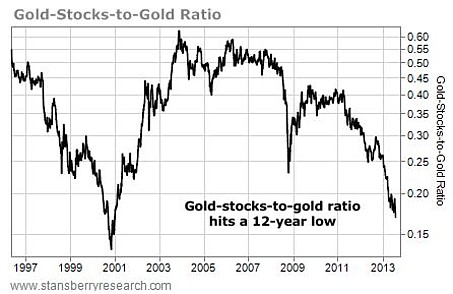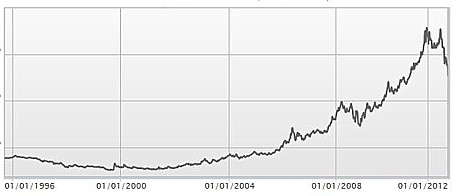<<< Go to start <<<
Page 4 of 4 | 1 | 2 | 3 | 4 |
Let’s look at that chart again. Matt Badiali is not being entirely straight with Porter Stansberry’s hard-won readers. True, if you look somewhat carefully, you will see that the scale on the right of the graph is distorted to exaggerate the volatility when the “ratio” is low, and to minimise it when the ratio is high. It’s the same effect you get on Mercator projection maps which flatten out the world, making Canada and Antarctica appear much bigger than they actually are, and Africa considerably smaller.

This certainly helps to make those troughs look impressive. But there’s something else Badiali doesn’t explain. For this, you would need a second graph, tracking the price of gold thoughout the period he has identified. I’ve borrowed one from Bullion By Post, which provides an admirable chart service on its website (the two don’t entirely align, so you have to look carefully).

The comparison shows that, far from November 2000 – when Badliali’s ratio is at its lowest – being a time for rampant leaps in gold prices, things actually remained relatively subdued for the next six months. The monthly averages for the pm London fix were $266.01 for November 2000, and then for the next six months: $271.45; 265.49; $261.86; 263.03; $260.48 and $272.35.
In fact, gold didn’t really rise in any consequential manner until almost a year after the date that Badiali proposes as so significant. And by this time, the ratio was rising. So Badiali has given quite wrong advice. On the basis of past performance of this purported indicator, you should not buy gold until the ratio is on the upswing.
Send money now!
But Badiali’s analysis is worse. It’s bullshit. Look at the periods between 2004 and 2008, then 2009 to 2012: fantastic, soaring prices in gold, with nothing consistent doing in his ratios. In short, the gold-stocks-to-gold-prices ratio tells you nothing.
As I’ve said before, nobody knows.
Which raises the question:what is Matt Badiali’s purpose? Which is the same as asking: what is Porter Stansberry’s?
The answer is straightforward: they want your money. And they know how to catch your attention.
